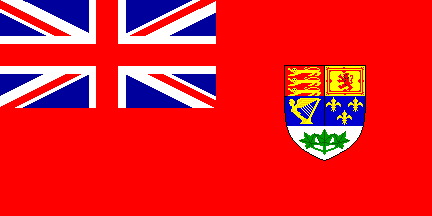For anyone who lived in Canada before 1964, the flag used was very different than the maple leaf flag from today. However, the flag used wasn't an official flag. Canada became a confederation in 1867, and the flag used was just simply the Union Jack from Great Britain. In the next few decades, it changed to the Red Ensign (a red flag with the Union Jack in the corner and the Canadian coat of arms opposite). It still wasn't an official flag though. The flag controversy began in 1924, but no consensus could be met, so it was dropped. It came up again 20 years later with the same result. In the early 1960's, the debate came up again, but this time, it wouldn't go away.
 |
| The Red Ensign |
The biggest problem in choosing a flag is honoring the past, pointing to the future, and appeasing most of those who will raise it. What made this so difficult for Canada was that there were three groups who needed to be appeased: those from the English background, those from the French background, and those who weren't from either. Those from the English background wanted to have the Union Jack in it, those from the French background wanted something French (such as the fleur-de-lys), and those that weren't English or French wanted something that uniquely Canadian. This made for intense debate.
The only symbol that anyone could seemingly look at without actually having strong reactions over was the sugar maple leaf. This symbol had been used in the past by Canadians, but it wasn't a strong well-used symbol. The real reason it was really considered was it was less of an irritation than the pro-English and pr-French symbols that were being considered. The pro-French symbol group were all right with the maple leaf mostly because it wasn't a union jack, and the pro-English symbol group were all right with the maple leaf mostly becuase it wasn't a fleur-de-lys. Some people, however, didn't like it because isn't uniquely Canadian nor does it have any real historical context. The other complaint was that the maple tree didn't grow any west of the province of Ontario.
So, after much more debate, and a narrowing down of ideas, there were three designs left: a three leaf design with blue on the left and right side, a one leaf design with a union jack in the upper left corner and a fleur-de-lys in the upper right corner, and a one leaf design which had 13 points.
 |
| Three Leaf Design |
The three leaf design looked too similar to a liberal party symbol, so it was thrown out. The compromise flag (with the union jack and fleur-de-lys) was thrown out because of too many objections. The only remaining choice was the single maple leaf. Citizens were encouraged to find symbology with the single maple leaf to Canadian life, which would smooth the firestorm. The new flag was voted on and approved finally. This flag has 13 points, and during the period after the voting, the points were lessened to 11. Some think that the points represent the 10 provinces and 1 country or 1 for the territories. Some think that the points mean the 11 governments of Canada: 10 provinces and 1 federal government, but the 2 territories have governments also. But this was all thought of after the flag was adopted, and have no bearing on the meaning of the maple leaf flag.
So, the moral of this story is that if anyone mentions why the Canadian flag was chosen, you will know that the real reason their flag has a maple leaf is basically because it was the least offensive design that would appease everyone involved. It wasn't that everyone loved the maple leaf; it was more that they didn't hate it as much as what the other side was proposing. And there's something about that which is amusing. Compromise, anyone?
Bet you didn't know that!
No comments:
Post a Comment